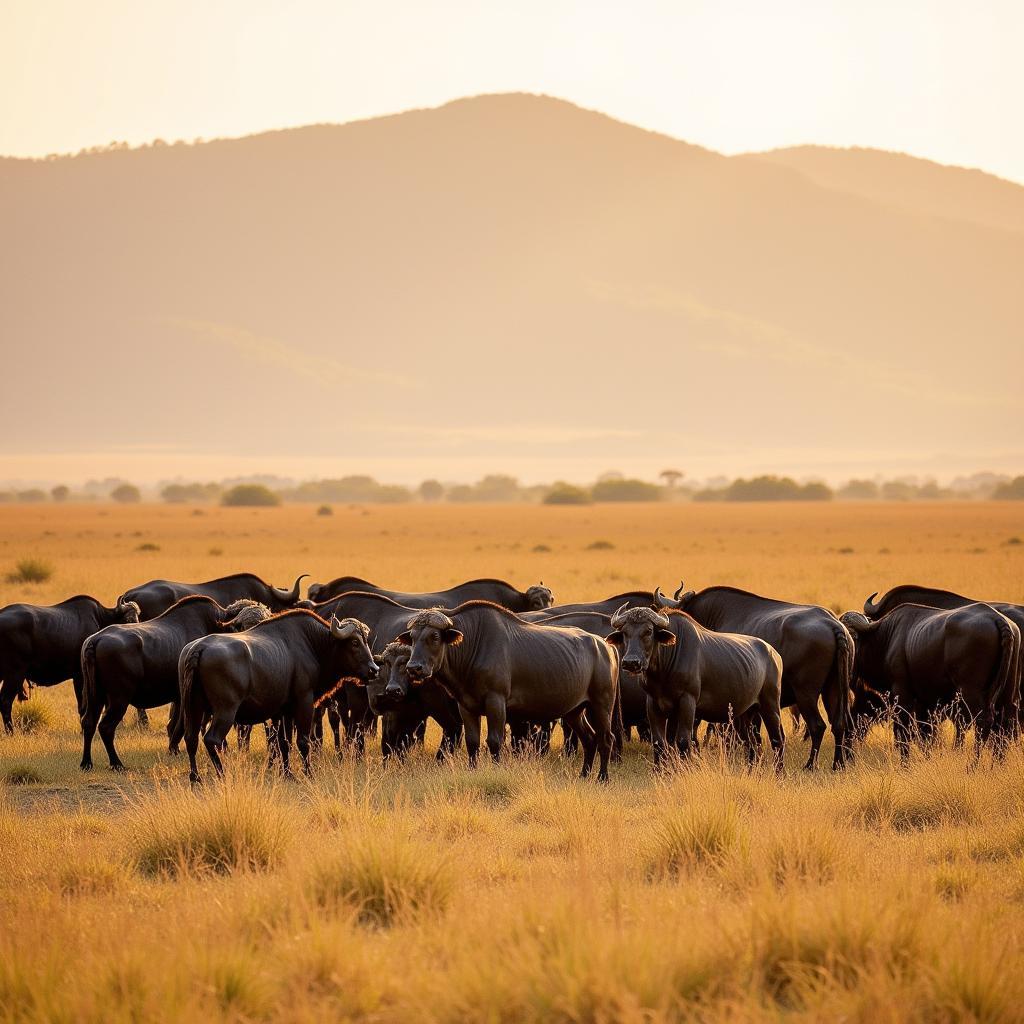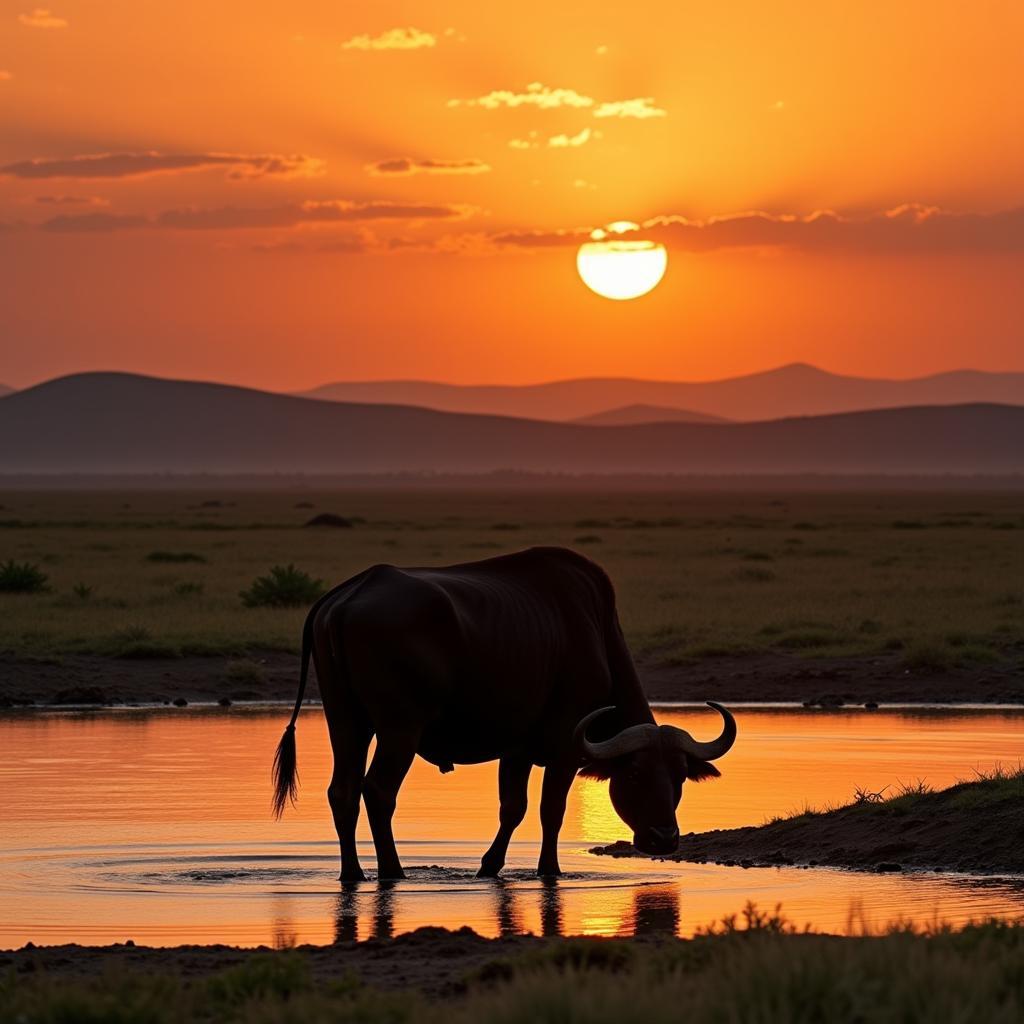Unveiling the African Bison-Like Animal: The Cape Buffalo
The African bison-like animal you’re likely thinking of is the Cape buffalo (Syncerus caffer), a powerful and iconic creature that roams the savannas and woodlands of sub-Saharan Africa. This majestic bovine is not a true bison, but its imposing size, formidable horns, and herd mentality often lead to comparisons. Let’s delve deeper into the fascinating world of this remarkable animal.
Understanding the Cape Buffalo: A Force of Nature
The Cape buffalo, also known as the African buffalo, is a large ungulate herbivore, weighing up to 2,000 pounds. Their thick, dark hide and impressive curved horns make them immediately recognizable. These horns, which can fuse at the base to form a solid “boss,” are a formidable weapon against predators.
The Social Structure of African Buffalo Herds
Cape buffalo are highly social animals, living in herds that can number from a few dozen to several hundred individuals. This herd mentality provides protection against predators like lions, leopards, and crocodiles. The collective strength and defensive formation of the herd can deter even the most persistent hunters. For more insights into their group dynamics, learn more about the african buffalo herd.
The herd structure is complex, with dominant males leading the group and protecting the females and young. Within the herd, there are intricate social hierarchies and interactions that contribute to the overall cohesion and survival of the group.
 Large Herd of Cape Buffalo Grazing on the African Savanna
Large Herd of Cape Buffalo Grazing on the African Savanna
What does an African Bison-Like Animal eat?
The Cape buffalo is a grazer, consuming large quantities of grass and other vegetation. Their diet plays a crucial role in shaping the ecosystem, influencing plant diversity and providing a food source for scavengers.
Where does the African Bison-Like Animal live?
The Cape buffalo’s habitat spans a wide range of ecosystems across sub-Saharan Africa. They thrive in savannas, woodlands, and even forested areas, adapting to diverse environments and playing a key role in the ecological balance. To understand their habitat requirements, check out african bison habitat. While they share some similarities with bison, they are distinctly adapted to the African environment. You might be interested in learning about another iconic African animal, the african animal bison.
Distinguishing the Cape Buffalo from Other Bovines
While the Cape buffalo is often referred to as an “African Bison Like Animal”, it’s important to distinguish it from true bison. Bison are found primarily in North America and Europe, while the Cape buffalo is exclusive to Africa. Physically, they differ in horn shape, body size, and coat texture.
The Danger of the Cape Buffalo
While majestic, the Cape buffalo is also considered one of Africa’s most dangerous animals. Their unpredictable nature and aggressive tendencies make them a formidable opponent. They are known to charge with surprising speed and power, defending themselves and their herd fiercely.
Dr. Anika Moolman, a wildlife biologist specializing in African megafauna, emphasizes the importance of respecting these animals: “The Cape buffalo is not to be underestimated. Their power and protective instincts make them a force to be reckoned with in the wild.”
Conservation Status of the Cape Buffalo
The Cape buffalo is currently listed as a species of Least Concern by the International Union for Conservation of Nature (IUCN). However, populations are facing ongoing threats from habitat loss, poaching, and disease.
Professor Jabari Olufemi, a conservationist based in Kenya, notes: “While the Cape buffalo isn’t currently endangered, continued conservation efforts are crucial to ensure its long-term survival. Protecting their habitat and mitigating the impact of human activities are essential for maintaining healthy populations.”
 Solitary Cape Buffalo Drinking at a Watering Hole
Solitary Cape Buffalo Drinking at a Watering Hole
Conclusion: The Majestic Cape Buffalo
The “african bison like animal,” the Cape buffalo, is a magnificent creature that embodies the wild spirit of Africa. Understanding their behavior, habitat, and the threats they face is crucial for their continued survival. While they might share some similarities with bison, the Cape buffalo is a unique and vital part of the African ecosystem. Let’s continue to appreciate and protect this iconic animal for generations to come. For further reading on African wildlife, you might be interested in the concerning topic of the african forest elephant extinct. Or, you might learn about african height tall people.
FAQ
- Are Cape buffalo aggressive? (Yes, they are known for their unpredictable and aggressive behavior.)
- What do Cape buffalo eat? (They are grazers, primarily consuming grass and other vegetation.)
- Where do Cape buffalo live? (They inhabit various ecosystems across sub-Saharan Africa, including savannas, woodlands, and forests.)
- What is the lifespan of a Cape buffalo? (They can live up to 20 years in the wild.)
- What are the main predators of Cape buffalo? (Lions, leopards, and crocodiles are their primary predators.)
- Are Cape buffalo endangered? (They are currently listed as Least Concern, but face threats from habitat loss, poaching, and disease.)
- What is the difference between a Cape buffalo and a bison? (While similar in appearance, they are distinct species. Bison are found in North America and Europe, while Cape buffalo are exclusive to Africa and possess different physical characteristics.)
When you need assistance, please contact us by phone: +255768904061, email: [email protected] or visit us at: Mbarali DC Mawindi, Kangaga, Tanzania. We have a 24/7 customer service team.
